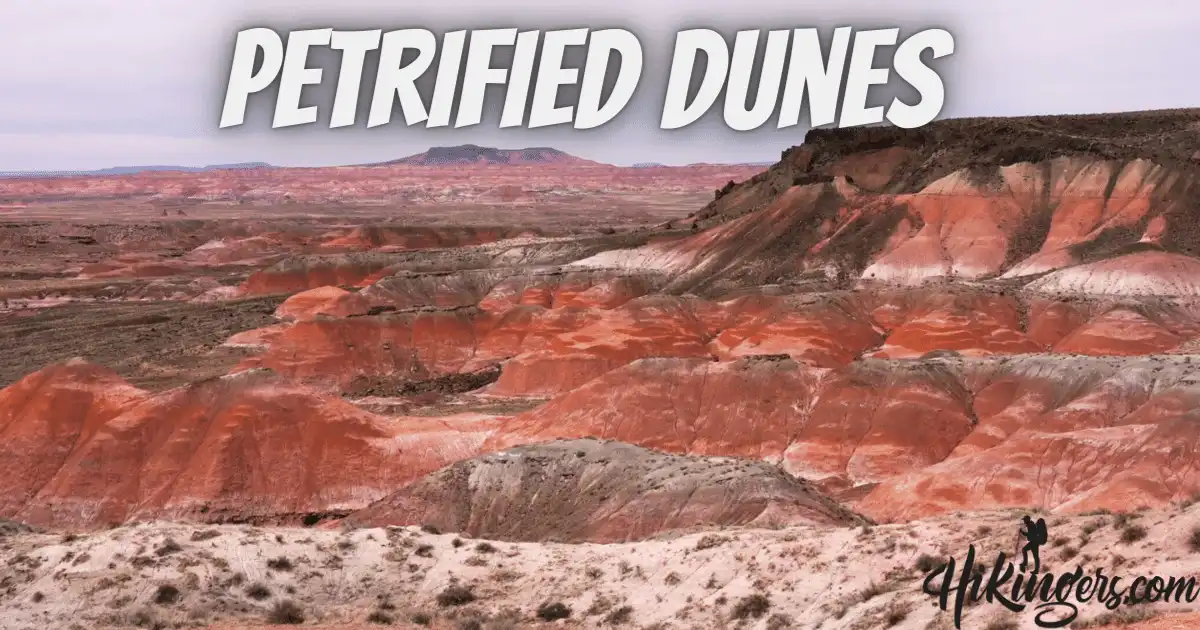Petrified dunes are formed when sand dunes become fossilized over long periods of time. This occurs when the dunes are buried under sediment that hardens into rock. The most famous examples are found in Arizona’s Petrified Forest National Park. The park contains deposits of petrified wood and fossilized sand dunes that are over 200 million years old.
The fossilized dunes often retain the original cross-bedding patterns of ancient sand dunes. Researchers can study these patterns to learn about wind directions and climate conditions when the dunes were active.
In addition to petrified wood, the dunes can contain opal, agate, and other types of minerals that replaced the original quartz sand grains via mineralization over time. This gives the dunes an ornate, colorful banded appearance.
Petrified dunes require specific conditions to form – large active dunes made of quartz sand, rapid burial by sediment, and minimal disturbance over millions of years. These conditions are rare, which makes fossilized dunes relatively uncommon worldwide.
Petrified Dunes Around the World

In a few rare places around the world, ancient sand dunes have turned to stone through fossilization. These petrified dunes offer a unique glimpse into past environments and climate conditions. Here are three notable locations where fossilized desert dunes can be seen.
Petrified Dunes at Arizona’s Petrified Forest National Park

The Painted Desert within Arizona’s Petrified Forest National Park contains magnificent deposits of petrified dunes up to 218 million years old. The dunes were rapidly buried by sediment and later transformed into rock through mineralization.
Cross-Bedding and Ripple Marks
The fossilized cross-bedding and ripple marks visible in the dunes provide details about wind patterns and surface conditions when the dunes were active over 200 million years ago.
Adjacent Fossilized Forest
Petrified tree trunks lie alongside the dunes, allowing researchers to study the interaction between the ancient dunes and nearby forest ecosystems.
Petrified Dunes of Argentina’s Neuquén Province
In Neuquén Province, petrified Erg-type sand seas dating to the Late Jurassic and Early Cretaceous periods contain vast deposits of fossilized sand dunes.
Valley of the Moon

The most extensive dune field is found in the Valley of the Moon, where wind erosion has uncovered dramatic formations.
Prehistoric Climate Research
The mineral composition and sedimentary structures of the petrified dunes provide clues to the paleoclimate conditions during the time when the dunes were active.
Australia’s Carnarvon Range

Western Australia’s Carnarvon Range holds fossilized dunes from the Miocene and Pliocene epochs. The dunes were buried by lake sediments between 10-30 million years ago.
Distinct Banding
Mineralization produced colorful banding in the dunes, making them popular for lapidary work.
Insight into Australia’s Geologic History
Studying the dunes sheds light on the paleogeography, climate shifts, and evolution of Australia’s landscape over millions of years.

Conclusion
The rare occurrence of petrified dunes worldwide provides unique snapshots of prehistoric environments long since vanished. These stony sands frozen in time continue revealing hidden details of our planet’s distant past. Researching petrified dunes allows scientists to reconstruct ancient ecologies, wind patterns, and climate conditions – granting us priceless insight into Earth’s remarkably dynamic history.
Frequently Asked Questions
How do sand dunes become petrified?
Petrified dunes form when active sand dunes are buried rapidly by sediment. Groundwater then flows through the pore spaces, depositing dissolved minerals that replace the original quartz sand grains while retaining original structures.
Where are the most famous petrified dunes located?
The Painted Desert’s petrified dunes in Arizona’s Petrified Forest National Park are among the most well-known and extensively studied petrified dunes in the world.
What can we learn by studying fossilized sand dunes?
The preserved sedimentary structures in petrified dunes provide clues about wind patterns, sand transport, dune formation processes, and surface conditions when the dunes were active many millennia ago.
How old are the oldest known petrified sand dunes?
Some of the most ancient petrified dunes are found in Argentina’s Neuquén Province, with deposits dating back over 140 million years to the Late Jurassic period.
Are fossilized dunes only found in desert regions?
No, petrified dunes can also form in areas that were once sandy coastlines, sand seas, or river environments. The key requirement is large active dunes made of quartz-rich sand.
You May Also Like

My name is David James I am an adventurous hiker based in California. Through this weblog, I percentage my passion for exploring nature’s wonders, documenting breathtaking trails and hidden gemstones.



